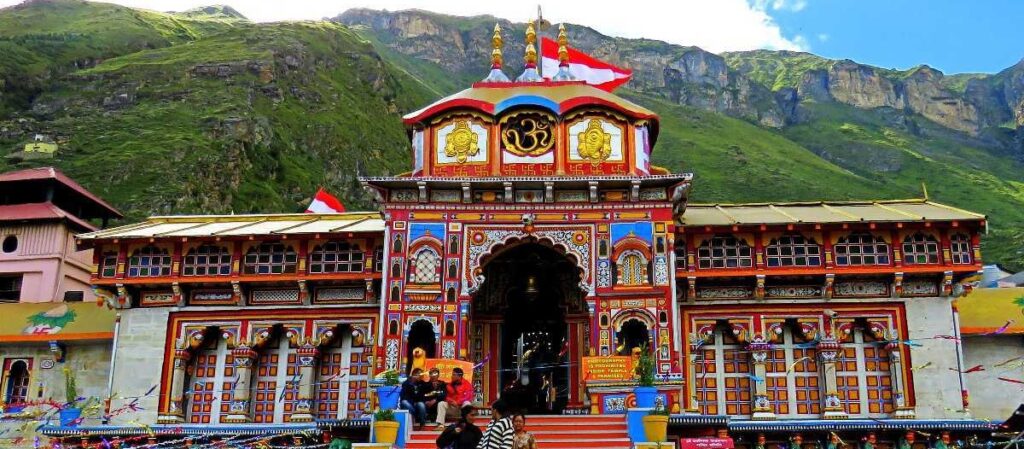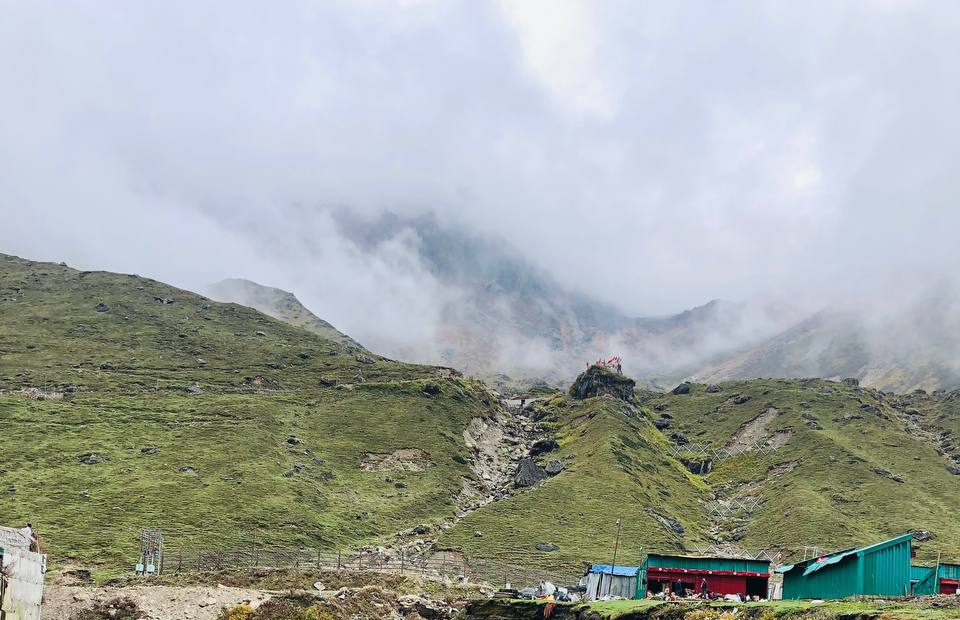
Overview of Badrinath Temple (Dham): Jai Badri Vishal
The beautiful town of Badrinath is where divinity meets natural serenity. The pre-eminent abode of Lord Vishnu is one of the holiest shrines of the Char Dham pilgrimage in India, located at a height of 3,133 meters in the Chamoli district of Uttarakhand. Dwarka, Puri, and Rameswaram are also Char Dham sites.
The pious land of Vishnu, located between the Nar and Narayan peaks, is also part of the Chota Char Dham Yatra in Uttarakhand. Starting with Yamunotri, Gangotri, and Kedarnath, Badrinath is the final and most celebrated stop on the Garhwal Himalayas pilgrimage tour. Badrinath Dham is easily accessible via motorable roads, and the Badrinath temple can be reached via an easy trek. Mana, about 3 kilometers from Badrinath, is one of the last villages before the Indian border and the Tibetan border meet. The peak of Neelkanth stands tall, radiating a powerful aura for all pilgrims and travelers alike.
Devotees worship several murtis in the temple, the most important of which is a one-meter-tall statue of Vishnu as Lord Badrinarayan made of black Saligram stone. Many Hindus regard the statue as one of the eight swayam vyakta keshtras, or self-manifested statues of Vishnu. The murti depicts Vishnu sitting in a meditative posture, as opposed to His far more common reclining posture. When the town of Badrinath closes in November, devotees move the image to nearby Jyotirmath. The temple benefits from the magnificence of the Himalayan mountains because it is located in the Nanda Devi Biosphere Reserve. Adi Shankara, the founder of Advaita Vedanta around 800 C.E., designated the site as a holy pilgrimage site.
Architecture of Badrinath
The temple has a modest cupola and a roof made of gold gilded that is around 50 feet (15 meters) in height. Arched windows may be found on the stone facade. The main entrance is reached by ascending a wide staircase to a massive archway. The outside is brilliantly painted and has an architecture that is similar to a Buddhist vihara (temple). The mandapa, a huge pillared corridor leading to the garbha grha, or major shrine space, is immediately within. The mandapa’s walls and pillars are covered with intricate sculptures. The main shrine area houses the black stone image of Lord Badrinarayan, sitting under a gold canopy, beneath a Badri Tree. Fifteen additional murtis have been placed around the temple for worship, including murtis of Nara & Narayana, Narasimha (the fourth incarnation of Vishnu), Lakshmi, Narada, Ganesha, Uddhava, Kubera, Garuda (the vehicle of Lord Narayan), and Navadurga. The typical prasad offered at Badrinath temple includes hard sugar candy, Pongal, Tulsi, and dry fruits. The Tapt Kund hot sulfur springs lay just below the temple. Reputed as medicinal, many pilgrims consider bathing in the springs before visiting the temple a requirement.
History of Badrinath
There are numerous places of pilgrimage in heaven, on earth, and throughout the world, but none have ever been equivalenting to Badri, according to historical texts, and none will ever match it. Along the banks of the Alaknanda River, it rises tall at 3,133 meters, proud of its colorful heritage. The Badrinath shrine, regarded as the most significant temple of Vishnu, is credited with founding it. He discovered the Lord Badri Saligram statue submerged in the Alaknanda River and put it in a cave close to Tapt Kund. The statue was housed in a temple that was built in the 16th century by a Garhwal King. Avalanches and earthquakes damaged the temple, necessitating several reconstructions, which led to the current structure. In addition to other gods such as Ganesha, Garud, Nar, Narayana, and Kuber, Lord Vishnu can also be worshipped as a black stone statue seated in a contemplative position. During the winter, Pandukeshwar’s Yogadhyan Badri receives the Lord Badri idol (Chamoli district).
Geography of Badrinath

The typical elevation of Badrinath is 3,100 metres (10,170 feet). On the banks of the Alaknanda River, in the Garhwal Himalayas. 9 kilometers east of Nilkantha peak, the town is situated between the Nar and Narayana Mountain ranges (6,596m). Badrinath is situated 301 kilometers north of Rishikesh and 62 kilometers from the Nanda Devi Mountain. By road, it takes 233 miles to get from Gaurikund (near Kedarnath) to Badrinath.
Weather in Badrinath
The region has a cold environment all year round.
Winter (October to April)
Usually, the days are freezing in the winter. The minimum temperature can drop below zero and snowfalls are frequent throughout the harsh winter. This is not the best time to visit Badrinath Dham.
Summer (May to June)
Especially these two months are ideal for the traveler to visit Badrinath with a little cool environment. Also, the summer season is perfect for sightseeing.
Monsoon (July to mid-September)
It is advised to avoid traveling during the rainy season from mid-July to mid-September since landslides and roadblocks are extremely prevalent which makes your travel more challenging.
How to reach
By Flight
Around 317 km away is the Jolly Grant Airport near Dehradun. Flights from several major Indian cities land here.
By Train
The Rishikesh Railway Station is 297 km away, while Kotdwar Railway Station is at a distance of 327km
By Road
The major cities of north India are well-connected to Badrinath. One can use buses that ply regularly from Delhi, Haridwar, and Rishikesh to Badrinath.
Badrinath Temple opening and closing Date
On May 8, 2022, Lord Badrinath welcomed travelers to its heavenly sanctuary. The day was chosen on the auspicious day of Basant Panchami at Raj Darbar, which was followed by the customary Gadu Ghada—the oil-filled pitcher that was delivered to the temple before its gates opened. On May 8, Lord Badrinath set out on his tour. Vijaya Dasham will select the Badrinath temple’s closure date (tentative 8th November) for the gateway in 2022.
Some other keypoints about Badrinath
10 best Places to visit near Badrinath:
Shri Badrinath ji temple Vashudhara falls Bheem pul/bridge
Tapt kund Saraswati river Vyas gufa/cave
Alka puri Brahma capal Narada kund
Mata Murti temple
Who destroyed Badrinath temple?
The Garhwal monarchs began work on the temple’s building and enlargement in the 17th century. However, the temple was severely damaged by the Himalayan earthquake in 1803. It was later rebuilt by the Maharaja of Jaipur, and it was finished before World War One.
What is Badrinath famous for?
Badrinath, also known as Badrinarayana Temple, is a Hindu temple dedicated to Vishnu in Badrinath, Uttarakhand, India. The temple is also one of the 108 Divya Desams—holy sites for Vaishnavites—dedicated to Vishnu, who is revered as Badrinath.
Will Badrinath disappear?
Many ages later, they gave birth to Arjuna and Krishna. One day, the temple is anticipated to vanish. According to an old myth, Badrinath Dham will one day submerge under water before emerging in a new form.
Is Badrinath higher than Kedarnath?
No, it is located in the Himalayas, about 3,100 m (10,171 ft) above sea level. Kedarnath is located in the Himalayas, about 3,583 m (11,755 ft) above sea level.
Which river flows in Badrinath?
Alakananda.
How far is Badrinath from Kedarnath?
218 Kms
How much does it cost to go to Badrinath?
The complete cost is around 15k to 20k if you are traveling from Delhi to Badrinath (Round tour).
How many days are enough for Badrinath?
Since there are so many attractions in and around Badrinath, it would take at least 3 days to leisurely visit the city and its surrounds. Mana Village, Vasudhara Falls, Tapta Kund, Bheem Pul, and others are a few of the must-see locations.
What time of year is ideal to visit Badrinath?
From late April or early May through late October or mid-November, the Badrinath Temple is open. Due to persistent snowfall during the remainder of the year, the temple is kept closed. May to June and September to October are the best months to visit the temple. Avoiding the late winter and monsoon months is strongly advised.
Thank you for visiting our website (Your Fact Houses)

